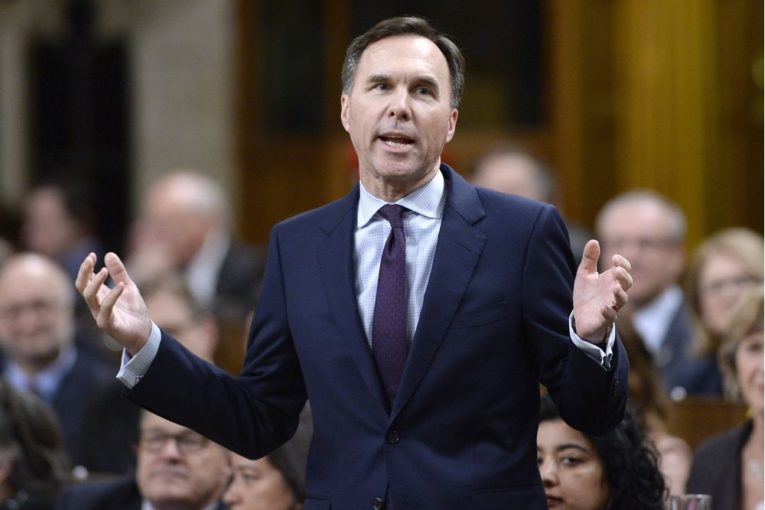
Wakey-wakey, Bill Morneau.
More money is flowing through the energy investment pipeline into the United States, while Canada isn’t yet ready to mount an aggressive campaign to attract capital here.
A new Statistics Canada report shows spending by oil and gas companies across the country will fall by 12 per cent this year to $33 billion, far off the $76-billion mark seen four years ago when commodity prices were riding high.
In Alberta, a similar 12 per cent decline is projected this year as spending on oilsands and conventional oil and gas tails off, and producers do more with less money.
Canada is now facing a teeter-totter effect.
Promising energy plays and tax reform are making the U.S. a more attractive place to invest. On the other side, pipeline constraints and the discount facing oil and natural gas prices in Alberta are beginning to pinch.
The heads of three of Canada’s largest petroleum producers say the country is falling behind.
“It is hard to not be concerned about Canada’s competitiveness right now,” Husky Energy CEO Rob Peabody said Thursday.
“Hopefully we’ll wake up to the situation and we’ll start taking some action to remedy it.”
Similarly, Canadian Natural Resources vice-chairman Steve Laut voiced concern that regulatory uncertainty and tax changes are tipping the scales.
“Clearly the U.S. has changed the structure, and they are clearly more competitive when it comes (to) a tax point of view. That does give them a cost of capital advantage,” he said in an interview.
“You actually see capital flow to the U.S. (from) Canada. They have regulatory advantages as well.”
Much attention has focused recently on the potential impact of U.S. tax reforms, dropping corporate tax rates to 21 per cent from 35 per cent. As well, the Americans have increased the pace of capital expense write-offs for machinery and equipment.
Business groups and corporate leaders were hoping Finance Minister Morneau would address these challenges in the federal budget on Wednesday, but were left disappointed.
Asked what the budget would do to make Canada’s energy sector more competitive, Crescent Point Energy CEO Scott Saxberg was blunt.
“Not much,” he said Thursday. “The understanding of competitiveness, obviously with this budget and just in general, hasn’t got to the federal level yet.”
Talking to reporters in Toronto, the finance minister said Thursday that he’ll monitor the U.S. tax situation and recognizes the importance of Canada remaining competitive.
But there was no firm promise to respond.
How long is Canada prepared to wait?
The Business Council of Canada pegs the combined average federal and provincial tax rate at 26.7 per cent, almost three percentage points above the world’s advanced economies.
It’s simplistic to say taxes are the only factor driving investment out of the Canadian energy sector, as the size of the prize in U.S. shale oil plays is luring capital south. As well, the differentials affecting Alberta oil and gas prices are squeezing returns on this side of the border.
The discount between Western Canadian Select heavy oil prices and West Texas Intermediate crude sat near US$25 a barrel on Wednesday. Laut expects the differentials will drop from current levels, but will be higher than they were last year.
Oil isn’t the only challenged commodity for Canada’s energy sector.
Alberta natural gas prices at the AECO hub traded at US$1.45 per thousand cubic feet on Wednesday, $1.20 below benchmark U.S. prices due to pipeline constraints.
Some producers have already cut spending programs for natural gas due to low prices. At Canadian Natural Resources, some gas production has been shut in and the company will drill only 17 gas development wells this year.
Part of the broader solution is for Canada to build new energy infrastructure.
But even if three proposed oil lines — Keystone XL, Enbridge’s Line 3 replacement project and the Trans Mountain expansion — move ahead, the Alberta government doesn’t see new capacity coming online until 2020 or beyond.
Another challenge is the uncertainty around Canada’s regulatory systems, such as the recent revamping of the federal approval process for new energy infrastructure.
Roll these factors together — along with improved efficiency by Canadian petroleum producers to spend less money, yet increase oil and gas output — and it’s all having an impact.
Earlier this week, the Canadian Association of Petroleum Producers launched a campaign to shine a spotlight on competitiveness issues.
It noted capital spending in the country sat at $45 billion last year, down 19 per cent from 2016 levels. But the U.S. oilpatch saw its spending jump 38 per cent in 2017.
“We are seeing lots of additional sorts of taxes coming in Canada, while at the same time the biggest competitor to the south — the big gorilla — is dropping taxes. So it makes it hard to take investment decisions, to put dollars into Canada,” said Peabody.
Laut agrees, noting Canada must improve the speed and efficiency of moving projects through the regulatory process so the country can get its oil and gas to customers.
“It is a concern,” he said.
“Canada is great place to do business, we have very high standards, we have talented people in Canada that are very innovative. It just means here in Canada we have to be that much-more innovative, that much-more effective and efficient to compete with the lower tax regimes in the world.”
For Saxberg, he’d like Ottawa to acknowledge it needs to step up.
“Canada has to be more competitive to attract dollars into Canada, because we’re up against some pretty formidable … high-return projects in the U.S.”
These are all factors the finance minister needs to consider at as Ottawa ponders how to reverse the decline of business investment since 2014.
In the meantime, Canada’s oilpatch is stuck waiting for Morneau.
Chris Varcoe is a Calgary Herald columnist.
You can read more of the news on source
